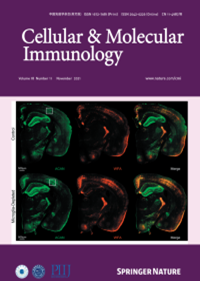MYO1F通过促进GAPDH乙酰化调节t细胞活化和糖酵解代谢。
IF 21.8
1区 医学
Q1 IMMUNOLOGY
引用次数: 0
摘要
适当的细胞代谢在T细胞是生产免疫反应的关键。然而,当受到内在或外在代谢因素的失调时,T细胞可能导致广泛的疾病,如癌症和自身免疫性疾病。然而,T细胞的代谢调控仍不完全清楚。在这里,我们表明MYO1F是TCR刺激后人类和小鼠t细胞激活所必需的,并且t细胞特异性MYO1F敲除小鼠由于体内t细胞激活受损而表现出肿瘤负担增加和EAE严重程度减轻。从机制上讲,在TCR刺激后,MYO1F在607和634酪氨酸位点被LCK磷酸化,这对于乙酰转移酶α-TAT1介导的甘油醛-3-磷酸脱氢酶(GAPDH)在Lys84、86和227位点的乙酰化至关重要,这些过程对于MYO1F的活化、细胞糖酵解以及T细胞的效应功能至关重要。重要的是,我们发现复发性外周t细胞淋巴瘤(PTCL)相关的致癌蛋白VAV1-MYO1F的融合蛋白可促进GAPDH的超乙酰化及其激活,从而导致异常的糖酵解和t细胞增殖,抑制GAPDH活性可显著限制t细胞的激活和增殖,并延长hVAV1-MYO1F敲入小鼠的存活时间。此外,在含有VAV1-MYO1F基因融合的人类PTCL患者样本中证实了GAPDH的超乙酰化。总的来说,本研究不仅揭示了MYO1F调节t细胞代谢和VAV1-MYO1F融合诱导PTCL的机制,而且还揭示了PTCL治疗的有希望的治疗靶点。本文章由计算机程序翻译,如有差异,请以英文原文为准。

MYO1F regulates T-cell activation and glycolytic metabolism by promoting the acetylation of GAPDH
Proper cellular metabolism in T cells is critical for a productive immune response. However, when dysregulated by intrinsic or extrinsic metabolic factors, T cells may contribute to a wide spectrum of diseases, such as cancers and autoimmune diseases. However, the metabolic regulation of T cells remains incompletely understood. Here, we show that MYO1F is required for human and mouse T-cell activation after TCR stimulation and that T-cell-specific Myo1f knockout mice exhibit an increased tumor burden and attenuated EAE severity due to impaired T-cell activation in vivo. Mechanistically, after TCR stimulation, MYO1F is phosphorylated by LCK at tyrosines 607 and 634, which is critical for glyceraldehyde-3-phosphate dehydrogenase (GAPDH) acetylation at Lys84, 86 and 227 mediated by α-TAT1, which is an acetyltransferase, and these processes are important for its activation, cellular glycolysis and thus the effector function of T cells. Importantly, we show that a fusion protein of VAV1-MYO1F, a recurrent peripheral T-cell lymphoma (PTCL)-associated oncogenic protein, promotes hyperacetylation of GAPDH and its activation, which leads to aberrant glycolysis and T-cell proliferation, and that inhibition of the activity of GAPDH significantly limits T-cell activation and proliferation and extends the survival of hVAV1-MYO1F knock-in mice. Moreover, hyperacetylation of GAPDH was confirmed in human PTCL patient samples containing the VAV1-MYO1F gene fusion. Overall, this study revealed not only the mechanisms by which MYO1F regulates T-cell metabolism and VAV1-MYO1F fusion-induced PTCL but also promising therapeutic targets for the treatment of PTCL.
求助全文
通过发布文献求助,成功后即可免费获取论文全文。
去求助
来源期刊
CiteScore
31.20
自引率
1.20%
发文量
903
审稿时长
1 months
期刊介绍:
Cellular & Molecular Immunology, a monthly journal from the Chinese Society of Immunology and the University of Science and Technology of China, serves as a comprehensive platform covering both basic immunology research and clinical applications. The journal publishes a variety of article types, including Articles, Review Articles, Mini Reviews, and Short Communications, focusing on diverse aspects of cellular and molecular immunology.

 求助内容:
求助内容: 应助结果提醒方式:
应助结果提醒方式:


